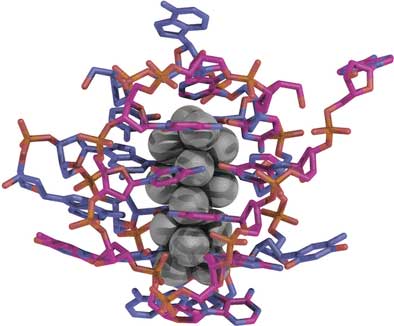| Sep 11, 2019 | |
Little heaps of silver, all wrapped up(Nanowerk News) Nanoclusters are little "heaps" of a few atoms that often have interesting optical properties and could become useful probes for imaging processes in areas such as biomedicine and diagnostics. |
|
| In the journal Angewandte Chemie ("Crystal structure of a NIR-Emitting DNA-Stabilized Ag16 Nanocluster"), researchers have introduced a nanocluster of 16 silver atoms stabilized by a wrapping of DNA strands. Using X-ray analysis, they were able to determine the crystal structure and identify important interactions within it. | |
| In contrast to solids or nanoparticles, nanoclusters, like molecules, can switch between discrete energy levels by absorbing or emitting light (fluorescence). Nanoclusters made of silver are especially interesting--in particular because they can fluoresce very brightly. | |
| Their optical properties depend strongly on the size of the nanoclusters, so it is important to make individual clusters with a precisely defined number of atoms. | |
| For several years, scientists have been using short DNA strands as biocompatible, water-soluble alternatives to conventional "templates". | |
| A team led by Tom Vosch at the University of Copenhagen, Denmark, and Jiro Kondo at Sophia University, Tokyo, Japan, have crystallized a nanocluster of exactly 16 silver atoms using a DNA sequence of ten nucleotides. The magenta crystals emit light in the near infrared when irradiated with green light, with nearly identical spectra as a crystal or in solution. | |
 |
|
| A nanocluster of 16 silver atoms stabilized by a wrapping of DNA strands. (© Angewandte Chemie) | |
| Structural analysis revealed that the Ag16 nanoclusters have a diameter of about 7 Å and a height of about 15 Å (1 Å is one ten millionth of a millimeter). Each nanocluster is tightly wrapped and almost completely shielded by two DNA strands in a horseshoe conformation. The two DNA strands are primarily bound by interactions with the silver atoms and to some extent by a few hydrogen bonds. | |
| Surprisingly, none of the Watson-Crick base pairing typically observed for DNA is found in this case. Additionally, novel silver-silver interactions were observed within the cluster. | |
|
Packing of the DNA-silver nanoclusters into the crystal is promoted by various interactions, including those between phosphate groups and calcium ions, and |
|
| Additionally, loosely associated silver cations are present within the crystal; some form a bridge between DNA bases, while others interact only with silver atoms within the core of the clusters. | |
| These new insights could help to explain the relationship between the structural and emission properties of nanoclusters, and to develop a method for the synthesis of further monodisperse, biocompatible, water-soluble silver clusters with advantageous photophysical features for applications such as biomedical imaging. |
| Source: Wiley | |
|
Subscribe to a free copy of one of our daily Nanowerk Newsletter Email Digests with a compilation of all of the day's news. |
